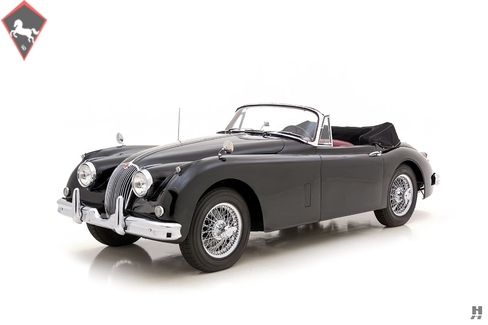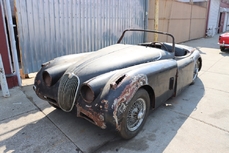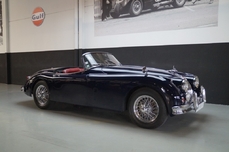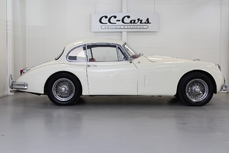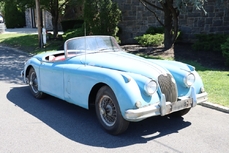Jaguar XK150 Drop Head Coupe 1959
General description :
Introduced in May 1957, the new XK150 built on Jaguar’s rich heritage including the XK120 and XK140 before it, marking the third and final evolution of the brilliant XK-series sports cars from Jaguar. While continuing to use a shortened Mark V chassis and bearing a strong resemblance to its predecessors, the XK150 was slightly wider and featured cleaner styling with a higher and more subtle beltline replacing the trendy cut-down doors of the XK120 and XK140. A wider grille element improved engine cooling and a modern one-piece curved windscreen provided improved forward visibility. At launch, the XK150 was available in both Fixed Head and Drophead Coupe body styles, with the Open Two-Seater (Roadster) following them to market by March 1958.
From the start, Jaguar applied the lessons gained from competition to its sporting road cars, which steadily grew in performance and sophistication. A clear case of racing improving the breed, the XK150 was Jaguar’s first road model equipped with Dunlop four-wheel disc brakes, which played a key role in the company’s second Le Mans victory with the C-Type in 1953. Until late 1959, Jaguar’s already-legendary XK DOHC inline ‘six’ powered the XK150 in 3.4-liter form with a stout 190-bhp rating. While the XK150 was designed strictly as a fast, GT-oriented road car, a few committed privateers campaigned it to good effect, including the GT-class win at the 1960 Tulip Rally and Walt Hansgen’s creditable third-place podium at Bridgehampton in June 1960.
Bearing Chassis Number S838005, this original left-hand drive XK150 Drophead Coupe (DHC) was built on January 6, 1959, and dispatched on January 23, 1959, to America via Jaguar Cars, New York. Continuing to sport its original color combination of Black paint, Red upholstery, and a Black convertible top, this XK150 retains the original body and original, matching numbers DOHC ‘XK’ engine with dual SU carburetors. In addition to its intrinsic desirability, this 1959 Jaguar XK150 is quite rare according to marque experts as one of just 2,682 examples produced with the Drophead Coupe body style, 2,133 of which – including this XK150 – were original Export models.
Owned by the previous owner from 2006 to mid-2021, this XK150 continues to benefit from restoration and proper maintenance and mechanical sorting for an excellent driving experience on command. Thoughtful upgrades for enhanced reliability include an extra-capacity aluminum radiator and electric cooling fan for enjoyment on long-distance tours and spirited drives. A recent mechanical service performed in April 2021 include a fuel tank service, ignition servicing, an oil change and installation of new spark plugs and a new fuel filter. A thorough detailing included paint correction. Accompanying documents include a Jaguar Daimler Heritage Trust Certificate, a maintenance and service booklet, and an owner’s manual, plus a selection of work orders and service receipts. Featuring great colors and ddelivering immense character and presence, this sophisticated 1959 Jaguar XK150 3.4-litre Drophead Coupe it is more than worthy of continued preservation and appreciation, just as it has enjoyed under the prior ownership.
Offers welcome and trades considered
1959 Jaguar XK150 Drop Head Coupe is listed for sale on ClassicDigest in St. Louis by Hyman Ltd. for $149500.
Car Facts
Car type : Car Make : Jaguar Model : XK150 Model Version : Drop Head Coupe Engine size : 0.0 Model Year : 1959 Sub type : Coupé Location : Missouri Vehicle Registration : Undefined
149500 $
People who viewed this Jaguar XK150 also viewed similar Jaguar listed at ClassicDigest
Other cars listed for sale by this dealer
About Jaguar
Ah, the story of Jaguar, from its early days as the SS Cars Ltd. to its pinnacle with the D-type, and the street-going evolution in the form of the iconic E-type. There's something quintessentially British about this tale, and I'll narrate it as a British journalist might.In the Beginnings:
Our journey into the world of Jaguar begins in the 1930s, when a company known as SS Cars Ltd. emerged. Despite the unfortunate coincidence of their initials with the rising political tensions in Europe, they started producing stylish and performance-oriented cars. The SS 100, introduced in 1936, was a symbol of elegance and speed, setting the stage for what would become Jaguar.
The Birth of Jaguar:
As the shadows of World War II loomed, SS Cars Ltd. wisely decided to disassociate themselves from the SS initials. Thus, in 1945, they officially became Jaguar Cars Ltd., a name that would soon be synonymous with British luxury and performance.
The XK Series:
Jaguar's post-war era brought us the XK 120, a true sensation in 1948. With its sleek design and a powerful 3.4-liter inline-six engine, it became the world's fastest production car. The XK 120 was the blueprint for what lay ahead – Jaguars that blended style with speed in a uniquely British fashion.
The D-type Dominance:
Then came the D-type, a true racing legend. Introduced in 1954, it won Le Mans three times in the 1950s, showcasing Jaguar's engineering prowess. With its innovative monocoque construction and the iconic fin at the back, the D-type was the apex of Jaguar's motorsport success.
The E-type Emergence:
But the true turning point arrived in 1961 with the introduction of the E-type, often described by Enzo Ferrari as "the most beautiful car ever made." Its long bonnet, curvaceous body, and a 3.8-liter engine delivering exhilarating performance made it an instant classic. The E-type was not just a car; it was a work of art on wheels, and it could hit 150 mph on the road.
Street and Racing Success:
The E-type's beauty was matched by its capability on the track. The lightweight E-types were particularly successful in various racing events, cementing Jaguar's reputation as a force to be reckoned with in motorsport.
The Age of Refinement:
As we delve deeper into the Jaguar story, we find that the 1950s and 1960s were an age of refinement and expansion. Alongside the magnificent D-type and the E-type's iconic emergence, Jaguar introduced models that further solidified its reputation for luxury and performance.
The MK2:
In the late 1950s, Jaguar unveiled the MK2, a sports sedan that combined elegance with power. This sleek four-door saloon was a favorite of bank robbers and law enforcement alike, thanks to its exceptional speed and handling. The MK2 was a symbol of Jaguar's ability to blend sophistication with performance and had a successful racing career as well.
The XJ6:
Fast forward to 1968, and Jaguar launched a car that would define luxury saloons for decades to come – the XJ6. It was a masterpiece of engineering and design, featuring a smooth inline-six engine, independent rear suspension, and a spacious, beautifully appointed interior. The XJ6 was a symbol of British elegance and provided a ride so smooth that it seemed to glide over the road. It became the flagship model for Jaguar and set the standard for luxury saloons, showcasing a level of refinement that left competitors in awe.
The Blend of Classic and Modern:
While the MK2 and XJ6 represented the evolution of Jaguar's saloon cars, they maintained the brand's commitment to performance and luxury. These cars didn't just belong on the racetrack; they were equally at home cruising down the grand boulevards or gliding through the English countryside.
The Challenges of Change:
However, as the 1970s arrived, Jaguar, like many British automakers, faced financial challenges and changes in ownership. The British Leyland era brought both opportunities and struggles, as the brand navigated through various mergers and transitions.
Nevertheless, the legacy of the MK2 and XJ6, along with the D-type and E-type, continues to define Jaguar as a manufacturer that combines timeless elegance with a spirit of performance. These classic models, whether driven on winding roads or parked as collectors' treasures, serve as a testament to Jaguar's enduring presence in the world of automotive excellence.
The Jaguar story, from its early days as SS Cars Ltd. to the creation of automotive icons like the E-type, MK2, and XJ6, is a journey that reflects the very essence of British motoring – a blend of luxury, power, and style that continues to captivate enthusiasts and connoisseurs alike.
